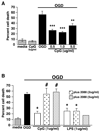Toll-like receptor 9: a new target of ischemic preconditioning in the brain
- PMID: 18183029
- PMCID: PMC3037270
- DOI: 10.1038/sj.jcbfm.9600606
Toll-like receptor 9: a new target of ischemic preconditioning in the brain
Abstract
Preconditioning with lipopolysaccharide (LPS), a toll-like receptor 4 (TLR4) ligand, provides neuroprotection against subsequent cerebral ischemic brain injury, through a tumor necrosis factor (TNF)alpha-dependent process. Here, we report the first evidence that another TLR, TLR9, can induce neuroprotection. We show that the TLR9 ligand CpG oligodeoxynucleotide (ODN) can serve as a potent preconditioning stimulus and provide protection against ischemic brain injury. Our studies show that systemic administration of CpG ODN 1826 in advance of brain ischemia (middle cerebral artery occlusion (MCAO)) reduces ischemic damage up to 60% in a dose- and time-dependent manner. We also offer evidence that CpG ODN preconditioning can provide direct protection to cells of the central nervous system, as we have found marked neuroprotection in modeled ischemia in vitro. Finally, we show that CpG preconditioning significantly increases serum TNFalpha levels before MCAO and that TNFalpha is required for subsequent reduction in damage, as mice lacking TNFalpha are not protected against ischemic injury by CpG preconditioning. Our studies show that preconditioning with a TLR9 ligand induces neuroprotection against ischemic injury through a mechanism that shares common elements with LPS preconditioning via TLR4.
Conflict of interest statement
Figures





Similar articles
-
TLR9 bone marrow chimeric mice define a role for cerebral TNF in neuroprotection induced by CpG preconditioning.J Cereb Blood Flow Metab. 2012 Dec;32(12):2193-200. doi: 10.1038/jcbfm.2012.140. Epub 2012 Sep 26. J Cereb Blood Flow Metab. 2012. PMID: 23010947 Free PMC article.
-
Endotoxin preconditioning protects against the cytotoxic effects of TNFalpha after stroke: a novel role for TNFalpha in LPS-ischemic tolerance.J Cereb Blood Flow Metab. 2007 Oct;27(10):1663-74. doi: 10.1038/sj.jcbfm.9600464. Epub 2007 Feb 28. J Cereb Blood Flow Metab. 2007. PMID: 17327883
-
The TLR9 ligand, CpG-ODN, induces protection against cerebral ischemia/reperfusion injury via activation of PI3K/Akt signaling.J Am Heart Assoc. 2014 Apr 10;3(2):e000629. doi: 10.1161/JAHA.113.000629. J Am Heart Assoc. 2014. PMID: 24721797 Free PMC article.
-
Inhalational anesthetics as neuroprotectants or chemical preconditioning agents in ischemic brain.J Cereb Blood Flow Metab. 2007 Jun;27(6):1108-28. doi: 10.1038/sj.jcbfm.9600410. Epub 2006 Oct 18. J Cereb Blood Flow Metab. 2007. PMID: 17047683 Free PMC article. Review.
-
Mechanisms of neuroprotection during ischemic preconditioning: lessons from anoxic tolerance.Comp Biochem Physiol A Mol Integr Physiol. 2007 Jun;147(2):291-9. doi: 10.1016/j.cbpa.2006.08.032. Epub 2006 Aug 30. Comp Biochem Physiol A Mol Integr Physiol. 2007. PMID: 17045830 Free PMC article. Review.
Cited by
-
Modeling dynamic regulatory processes in stroke.PLoS Comput Biol. 2012;8(10):e1002722. doi: 10.1371/journal.pcbi.1002722. Epub 2012 Oct 11. PLoS Comput Biol. 2012. PMID: 23071432 Free PMC article.
-
Cross talk of the first-line defense TLRs with PI3K/Akt pathway, in preconditioning therapeutic approach.Mol Cell Ther. 2015 May 30;3:4. doi: 10.1186/s40591-015-0041-7. eCollection 2015. Mol Cell Ther. 2015. PMID: 26056605 Free PMC article.
-
TLR9 bone marrow chimeric mice define a role for cerebral TNF in neuroprotection induced by CpG preconditioning.J Cereb Blood Flow Metab. 2012 Dec;32(12):2193-200. doi: 10.1038/jcbfm.2012.140. Epub 2012 Sep 26. J Cereb Blood Flow Metab. 2012. PMID: 23010947 Free PMC article.
-
Neuroimmune Response in Ischemic Preconditioning.Neurotherapeutics. 2016 Oct;13(4):748-761. doi: 10.1007/s13311-016-0465-z. Neurotherapeutics. 2016. PMID: 27525700 Free PMC article. Review.
-
The role of Toll-like receptor signaling pathways in cerebrovascular disorders: the impact of spreading depolarization.J Neuroinflammation. 2020 Apr 7;17(1):108. doi: 10.1186/s12974-020-01785-6. J Neuroinflammation. 2020. PMID: 32264928 Free PMC article. Review.
References
-
- Abramoff MD, Magelhaes PJ, Ram SJ. Image Processing with Image. J. Biophotonics International. 2004;11:36–42.
-
- Applequist SE, Wallin RP, Ljunggren HG. Variable expression of Toll-like receptor in murine innate and adaptive immune cell lines. Int Immunol. 2002;14:1065–1074. - PubMed
-
- Bordet R, Deplanque D, Maboudou P, Puisieux F, Pu Q, Robin E, Martin A, Bastide M, Leys D, Lhermitte M, Dupuis B. Increase in endogenous brain superoxide dismutase as a potential mechanism of lipopolysaccharide-induced brain ischemic tolerance. J Cereb Blood Flow Metab. 2000;20:1190–1196. - PubMed
-
- Bowman CC, Rasley A, Tranguch SL, Marriott I. Cultured astrocytes express toll-like receptors for bacterial products. Glia. 2003;43:281–291. - PubMed
Publication types
MeSH terms
Substances
Grants and funding
LinkOut - more resources
Full Text Sources
Other Literature Sources

